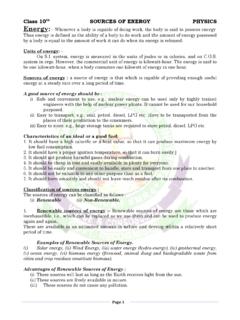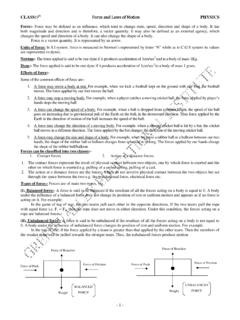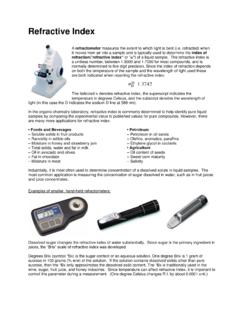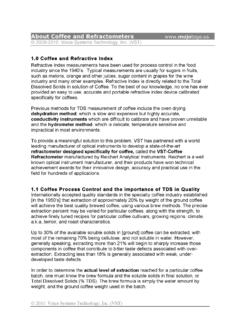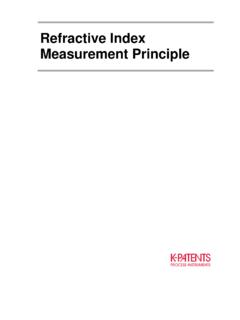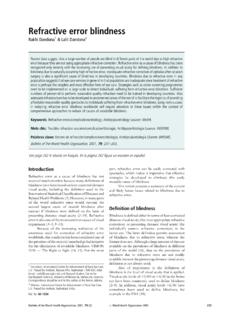Transcription of Class 10 th Physics LIGHT – REFLECTION AND …
1 Page 1 Class 10th Physics LIGHT REFLECTION AND refraction LIGHT LIGHT is a form of energy, which induces the sensation of vision in our eyes and makes us able to see various things present in our surrounding. UNITS OF LIGHT Any object which has an ability of producing LIGHT energy at its own is called as the source of denoted by letter d . SOURCE OF LIGHT Any object which has an ability of producing LIGHT energy at its own is called as the source of LIGHT . , Sun, Firefly, Battery, Cell Candle, Bulb etc. KINDS OF SOURCES OF LIGHT There are two main kinds of sources of LIGHT viz: 1) Natural Sources:- These include all those sources which are natural and possess their own LIGHT for example stars, firefly etc.
2 2) Artificial sources:- These include all those sources which are man-made or artificial but possess the ability of emitting LIGHT for example candle, lantern, moon etc. REFLECTION It is a phenomenon of LIGHT in which a ray of LIGHT form one medium strikes a smooth polished surface and returns back into the same medium. LAWS OF REFLECTION The two laws of REFLECTION of LIGHT are:- 1. The incident ray, the normal and the reflected ray lie in the same plane. 2. The angle of incidence is equal to the angle of REFLECTION of a ray of LIGHT striking a smooth polished surface , <i = <r. refraction When a ray of LIGHT travelling in a homogenous medium, strikes a surface of separation between the two media, passes through it and goes into the second medium.
3 The phenomenon is referred to as refraction . LAWS OF refraction The two laws of refraction of LIGHT are: The incident ray, the refracted ray and the normal to the refracting surface at the point of incidence all lies in the same plane. The ratio of sine of angle of incidence of the sine of the angle of refraction is a constant for a given pair media ,. REFRACTIVE INDEX Refractive index of a medium is defined as the ratio of velocity of LIGHT in vacuum to the velocity of LIGHT in medium, , u = MIRROR A mirror is a piece of glass having at least one polished surface and one reflecting surface. SPHERICAL MIRROR Spherical mirror is that mirror whose reflecting surface is a portion of a hallow sphere of glass. It is of two main types, concave mirror and convex mirror.
4 1) Concave Mirror:- A concave mirror is that spherical mirror in which the process of REFLECTION takes place at the concave or curved surface as shown under: M = Constant Velocity of LIGHT in vacuum or air Velocity of LIGHT in the given medium Inner Curved or Reflecting Surface Outer Buldged or Polished Surface Page 2 Class 10th Physics LIGHT REFLECTION AND refraction 2) Convex Mirror:- A convex mirror is that spherical mirror in which the process of REFLECTION takes place at the convex or bulging out surface as shown under: Terms associated with spherical mirrors:- The various terms associated with spherical mirrors are: 1) Center of curvature:- The centre of curvature of a spherical mirror is the central point of the hallow sphere of which the mirror is a part.
5 2) Radius of curvature:- The radius of curvature of a spherical mirror is the radius of the hallow sphere of which the mirror is a part, in other words, it is the distance between the centre of curvature and pole of a mirror. It is represented by letter R. 3) Pole:- The pole of spherical mirror is the centre or middle point of a spherical mirror. It is represented by letter P. 4) Principle axis:- Principle axis of a spherical mirror is the line passing through the centre of curvature and its pole. In other words, it is the line joining the pole and centre of curvature of a mirror. 5) Secondary axis:- Any straight line other than the principal axis passing through the centre of a spherical mirror is referred to as secondary axis.
6 It is usually represented by letters SS . 6) Aperture of a mirror:- Aperture of a mirror is the portion of a mirror from which REFLECTION of LIGHT takes place. In other words it is the maximum size of a mirror. It is usually represented by letter M and M/ . Sign conventions for spherical mirrors:- M M M Outer Bulged or Reflecting Surface Inner Curved or Polished Surface Positive Axis Positive distance Negative distance Negative distance Positive distance Image Direction of incident LIGHT M M MMObject Page 3 Class 10th Physics LIGHT REFLECTION AND refraction The various sign conventions employed for measuring distances in case of spherical mirrors are: For the measurement of all the distances, the pole of the mirror is taken as origin.
7 All the distances measured in the same direction as that of LIGHT are taken as positive for example the focal length of a convex mirror is taken as positive. Object is placed on All he distances measured against the direction of incident LIGHT are taken as negative for example the focal length of a concave mirror is taken as negative. All the distances measured upward and perpendicular to the principle axis are taken as positive, , height of an object, or image formed above principle axis. All the distances measured downward and perpendicular to the principal axis are taken as negative , image of an object below principle axis. Terms associated with concave mirror:- The various terms associated with the concave mirror are: 1) Principal focus:- The principal focus of a concave mirror is defined as the point on its principle axis to which all the incident rays parallel and close to the axis converge after REFLECTION through the mirror.
8 It is represented by letter F and lies always in front of a concave mirror, thus a real focus. 2) Focal length:- The focal length of a concave mirror is defined as the distance between the pole and principle focus of a concave mirror. It is represented by letter f and is always taken as negative. Terms associated with convex mirror: The various terms associated with a convex mirror: Page 4 Class 10th Physics LIGHT REFLECTION AND refraction 1) Principal focus : The principle focus of a convex mirror is the point on its principal axis to which a beam of LIGHT rays, initially parallel and close to the axis, appears to diverge after being reflected from the mirror. A convex mirror has a virtual focus and lies always behind the mirror.
9 It is represented by letter F. 2) Focal length : The focal length of a convex mirror is the distance between its pole and principle focus, it is represented by letter f, and is always taken as positive. OPTICLA IMAGE If a beam of LIGHT emitted by an illuminated object suffers a change in the direction due to REFLECTION or refraction , the reflected or refracted rays of LIGHT converge or appear to diverge from another point. This second point is referred to as optical image of the first point. The optical images formed by the spherical mirrors are of the following types: (i) Real image: Those images, which can be transferred or formed on a screen, are called as real images. These images are formed by the actual intersection of reflected or refracted LIGHT rays.
10 (ii) Virtual Images: Those images, which can be seen only by looking into a mirror, but cannot be transferred or formed on a screen, are called as virtual images. These images are formed by the apparent intersection of the reflected or refracted LIGHT rays. (iii)Erect Images: Those images, which lie or are formed above the principle axis, are referred to as erect images. (iv) Inverted Images: Those images, which lie or are formed below the principle axis, are referred to as inverted images. These images are upside down in appearance. (v) Magnified Image: Those images, which are larger in size than the size of the object, are referred to as magnified images. (vi) Diminished Image: Those images, which are smaller in size than the size of the object , are referred to as magnified images.

